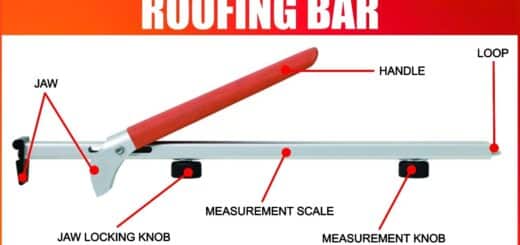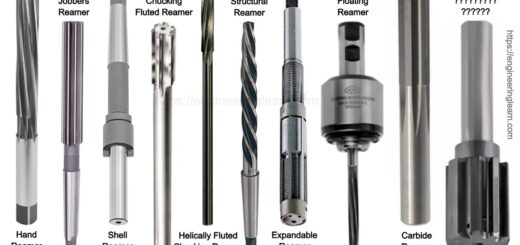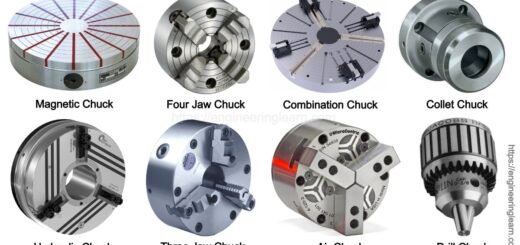Bevel Protractor – Types, Construction & Working Principle [Explained with Complete Details]
![Bevel Protractor - Types, Construction & Working Principle [Explained with Complete Details]](https://engineeringlearn.com/wp-content/uploads/2023/01/Bevel-Protractor-1024x539.jpg)
Introduction
Bevel Protractor – Types, Construction & Working Principle [Explained with Complete Details]: – A bevel protractor is an angle measuring tool that consists of a graduated circular scale and a coloured arm. A protractor is a spherical or semi-circular device used to measure an angle or circle in geometry. Normally, the units of measurement are degrees. Some protractors are half-discs that date back to antiquity. The bevel protractor, for example, is a more complex protractor with one or two swinging arms that help measure the angle.
The device can measure angles with a minimum count of 5′ or 5 minutes. It’s a tool for determining the angles of any workpiece. It’s used for a variety of things, including jigs. The bevel protractor is sometimes linked to the Vernier scale to get more accurate readings. In mechanical architectural drawing, the bevel protractor is quite useful. The development of software like CAD is diminishing the need for bevel protractors in general. Angles are measured with bevel protractors. It’s employed in a wide range of mechanical and technical applications.
Types of Bevel Protractor
1. Universal Bevel Protractor
The Universal Bevel Protractor is another name for the Vernier Bevel Protractor. It’s one of the angular measuring equipment that can achieve tight tolerances in just 5 minutes. Angular measurement devices are Bevel Protractors. The simplest angular measurement equipment is the Universal Bevel Protractor (Vernier Protractor), which has a Vernier Scale (similar to the Vernier Caliper) and an acute angle attachment.
Construction of Universal Bevel Protractor
- The main body will be mounted with the base plate (Stock) consisting of the Working edge.
- Also attached to the main body is the acute angle attachment.
- The Locking Nut makes installing and detaching this acute angle attachment simple.
- On the main body frame is added a circular plate with a vernier scale.
- This circular plate has an adjustable blade that can travel the length of the plate and be fixed in any position using the blade locking nut.
- The variable Blade One end is bevelled at 45 degrees, while the other is bevelled at 60 degrees.
- The major scale is a graduated scale on which the main body frame is built.
- On the main body, the circular plate can freely revolve.
- A slow-motion gadget controls the rotation of the circular plate on the main body.
Working Principle of Universal Bevel Protractor
- The Base Plate (Stock) serves as one of the working edges, while the blade, which is held on the circular plate, serves as the other. As you can see, the Universal Bevel Protractor (Vernier Bevel Protractor) can be used in various ways.
- Along with the circular plate on the main body, this Adjustment Blade can be turned.
- As illustrated in the diagram above, the vernier scale on the circular plate will be turned on the Main scale, which is graduated on the Main body.
- On each side of the central zero, the Vernier scale comprises 12 divisions. (This means the vernier scale has 24 divisions.)
- On the vernier scale, the 12 divisions represent 60 minutes (Like this 15, 30, 45, 60). For example, 12 divided by 60 equals 60 minutes.
- 60/12 = 5 minutes for one division.
- The identical section is represented as 23° on the Main scale (12 divisions on the vernier scale = 23° on the major scale).
- On the Vernier scale, one division equals 1.91666° = 1° 55′. (one degree 55 minutes)
- As Zero on the vernier scale travels on the main scale, it works similarly to the vernier caliper.
- The Zero line on the vernier scale shows the reading on the main scale, also known as the main scale reading while measuring.
- The divisions on the vernier scale will be the same as those on the main scale. The Vernier scale reading is the name given to this reading.
- We may determine the Reading using these variables and the Universal Bevel Protractor’s least count.
2. Optical Bevel Protractor
The optical bevel Protractor is a development of the Vernier Protractor with the inclusion of an optical magnifying device to achieve greater accuracy and precision in angular measurement for up to 2 minutes. The Vernier Bevel Protractor can only measure angle measurements for up to 5 minutes.
Construction of Optical Bevel Protractor
- The main body will be mounted with the base plate (Stock) consisting of the Working edge.
- Also attached to the main body is the acute angle attachment.
- The Locking Nut makes installing and detaching this acute angle attachment simple.
- On the main body frame is added a circular plate with a vernier scale. (The divisions on the optical bevel protractor’s vernier scale are remarkably similar to those on the Vernier bevel protractor’s vernier scale.)
- An optical magnifying device makes it easier to read the reading on the vernier scale.
- This circular plate has an adjustable blade that can travel the length of the plate and be fixed in any position using the blade locking nut.
- One end of the changeable Blade is bevelled at 45 degrees, while the other is bevelled at 60 degrees.
- The major scale is a graduated scale built into the main body structure.
- On the main body, the circular plate can freely revolve.
- A slow-motion gadget controls the rotation of the circular plate on the main body.
Working Principle of Optical Bevel Protractor
- The blade on the circular plate will operate as the second working edge, as the Base Plate (Stock) works as one of the working edges. As you can see, several of the OPtical bevel protractor’s sample points are in use.
- Along with the circular plate on the main body, this Adjustment Blade can be turned.
- This means that the circular plate’s vernier scale will be rotated on the Main scale, which is graduated on the Main body.
- On each side of the central zero, the Vernier scale comprises 12 divisions. (This means the vernier scale has 24 divisions.)
- On the vernier scale, the 12 divisions represent 60 minutes (Like this 15, 30, 45, 60). For example, 12 divided by 60 equals 60 minutes.
- 60/12 = 5 minutes for one division.
- The identical section is represented on the Main scale as 23° (12 divisions on the vernier scale = 23° on the major scale).
- On the Vernier scale, one division equals 1.91666° = 1° 55′. (one degree 55 minutes).
- As Zero on the vernier scale travels on the main scale, it works similarly to the vernier calliper.
- The Zero line on the vernier scale shows the reading on the main scale, also known as the main scale reading while measuring.
- The divisions on the vernier scale will be the same as those on the main scale. The Vernier scale reading is the name given to this reading.
- We may determine the Reading using these data and the optical Bevel Protractor’s least count.
Conclusion
It’s probably the easiest tool for determining the angle between two components’ faces. It is made up of a base plate that is attached to the main body, as well as an adjustable blade that is attached to a circular plate with a vernier scale. The movable blade can be fixed in any position and rotates freely around the centre of the primary scale engraved on the instrument’s body. An acute angle attachment is provided at the top to measure acute angles, as shown in the Figures. The base of the base plate is made flat so that it can be set flat on the work. Any angle can be calculated.
Content Source: – extrudesign, engineeringchoice
Image Source: – electricalworkbook













